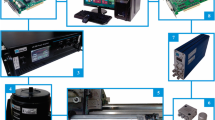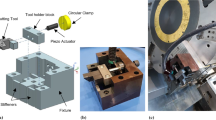Abstract
Strategies for chatter modelling, monitoring and reduction are constantly under research, as chatter is well known for jeopardizing the industry productivity and the quality of machined parts. This research presents two different strategies to reduce chatter by improving the stability limit in turning/boring operations using piezoelectric layers embedded in the tool-holder. Both rely upon the fact that structural damping has a proportional relationship with the stability limit. Being so, the instability phenomenon can be significantly reduced by increasing the system’s structural damping either passively or actively. In the proposed passive strategy, the piezoelectric layers are connected to a dissipative inductive-resistive shunt circuit. In the proposed active strategy, the piezoelectric layers are connected to a velocity feedback control scheme. The effectiveness of both strategies is evaluated by the comparison of numerical and experimental driving point Frequency Response Functions (FRFs) of the free end of the tool holder and experimental Stability Lobe Diagrams (SLDs). This numerical evaluation is performed using multiphysical finite element models and dedicated simulation schemes. The viability and robustness of both strategies are also experimentally examined by emulating different tool-holder’s fixation conditions, which modify the system’s dynamic characteristics. Operational experiments with both control strategies are also performed. It can be concluded that both strategies can be good alternatives for improving the stability limit in turning/boring operations, since they are capable of increasing the structural damping. Nevertheless, the proposed passive strategy lacks robustness since it requires the fine-tuning of the electrical components of the shunt circuit according to the system’s dynamic characteristics. Finally, in spite of some technical difficulties, the proposed active strategy presents satisfactory performance and robustness for its practical implementation.
Similar content being viewed by others
References
Munoa J, Beudaert X, Dombovari Z, Altintas Y, Budak E, Brecher C, Stepan G (2016) Chatter suppression techniques in metal cutting. CIRP Ann Manuf Techn 65(2):785–808
Ostasevicius V, Jurenas V, Augutis V, Gaidys R, Cesnavicius R, Kizauskiene L, Dundulis R (2016) Monitoring the condition of the cutting tool using self-powering wireless sensor technologies. Int J Adv Manuf Technol:1–15
Seemuang N, McLeay T, Slatter T (2016) Using spindle noise to monitor tool wear in a turning process. Int J Adv Manuf Technol 86:2781–2790
Yang Y, Zhang WH, Ma YC, Wan M (2016) Chatter prediction for the peripheral milling of thin-walled workpieces with curved surfaces. Int J Mach Tools Manuf 109:36–48
Wan M, Wang YT, Zhang WH, Yang Y, Dang JW (2011) Prediction of chatter stability for multiple-delay milling system under different cutting force models. Int J Mach Tools Manuf 51(4):281–295
Sun H, Zhang X, Wang J (2016) Online machining chatter forecast based on improved local mean decomposition. Int J Adv Manuf Technol 84:1045–1056
Parsian A, Magnevall M, Eynian M, Beno T (2016) Time domain simulation of chatter vibrations in indexable drills. Int J Adv Manuf Technol:1–13
Wan M, Ma YC, Feng J, Zhang WH (2016) Study of static and dynamic ploughing mechanisms by establishing generalized model with static milling forces. Int J Mech Sci 114:120–131
Corral J, Pinto C, Campa FJ, Altuzarra O (2016) Dynamic behavior verification of a lightweight machine for routing. Int J Adv Manuf Technol 86:1151–1163
Wan M, Altintas Y (2014) Mechanics and dynamics of thread milling process. Int J Mach Tools Manuf 87:16–26
da Silva MM, Venter GS, Varoto PS, Coelho RT (2015) Experimental results on chatter reduction in turning through embedded piezoelectric material and passive shunt circuits. Mechatronics 29:78–85
Pour DS, Behbahani S (2016) Semi-active fuzzy control of machine tool chatter vibration using smart MR dampers. Int J Adv Manuf Technol 83:421–428
Quintana G, Ciurana J (2011) Chatter in machining processes: a review. Int J Mach Tools Manuf 51 (5):363–376
Siddhpura M, Paurobally R (2012) A review of chatter vibration research in turning. Int J Mach Tools Manuf 61:27–47
Lopez De Lacalle LN, Lamikiz A, Salgado MA, Herranz S, Riveroda A (2002) Process planning for reliable high-speed machining of moulds. Int J Prod Res 40(12):2789–2809
Lamikiz A, Lopez de Lacalle LN, Sanchez JA, Bravo U (2005) Calculation of the specific cutting coefficients and geometrical aspects in sculptured surface machining. Mach Sci Technol 9(3):411–436
Fernndez-Abia AI, Barreiro J, Lpez de Lacalle LN, Martnez-Pellitero S (2012) Behavior of austenitic stainless steels at high speed turning using specific force coefficients. Int J Adv Manuf Technol 62(5):505–515
Uriarte L, Azcrate S, Herrero A, Lopez de Lacalle LN, Lamikiz A (2008) Mechanistic modelling of the micro end milling operation. P I Mech Eng B-J Eng 222(1):23–33
Campa FJ, De Lacalle LNL, Celaya A (2011) Chatter avoidance in the milling of thin floors with bull-nose end mills: model and stability diagrams. Int J Mach Tools Manuf 51(1):43–53
Urbikain G, Fernandez A, de Lacalle LNL, Gutierrez ME (2013) Stability lobes for general turning operations with slender tools in the tangential direction. Int J Mach Tools Manuf 67 :35–44
Urbikain G, Campa FJ, Zulaika JJ, de Lacalle LNL, Alonso MA, Collado V (2015) Preventing chatter vibrations in heavy-duty turning operations in large horizontal lathes. J Sound Vib 340 :317–330
Compean FI, Olvera D, Campa FJ, de Lacalle LNL, Elias-Zuniga A, Rodriguez CA (2012) Characterization and stability analysis of a multivariable milling tool by the enhanced multistage homotopy perturbation method. Int J Mach Tools Manuf 57 :27–33
Wan M, Ma YC, Zhang WH, Yang Y (2015) Study on the construction mechanism of stability lobes in milling process with multiple modes. Int J Adv Manuf Technol 79:589–603
Ganguli A, Deraemaeker A, Preumont A (2007) Regenerative chatter reduction by active damping control. J Sound Vib 300(3):847–862
Wu D, Zhao T, Chen K, Wang X (2009) Application of active disturbance rejection control to variable spindle speed noncircular turning process. Int J Mach Tools Manuf 49(5): 419–423
Yu DP, Hong GS, San Wong Y (2012) Profile error compensation in fast tool servo diamond turning of micro-structured surfaces. Int J Mach Tools Manuf 52(1):13–23
Matsubara A, Maeda M, Yamaji I (2014) Vibration suppression of boring bar by piezoelectric actuators and LR circuit. CIRP Ann Manuf Techn 63(1):373–376
Munoa J, Beudaert X, Erkorkmaz K, Iglesias A, Barrios A, Zatarain M (2015) Active suppression of structural chatter vibrations using machine drives and accelerometers. CIRP Ann Manuf Techn 64(1):385–388
Chen F, Hanifzadegan M, Altintas Y, Lu X (2015) Active damping of boring bar vibration with a magnetic actuator. IEEE/ASME Trans Mechatronics 20(6):2783–2794
da Silva MM, Cervelin JE, Calero DP, Coelho RT (2013) Availability study on regenerative chatter avoidance in turning operations through passive and active damping. Int J Mechatron Manuf Syst 6(5/6):455–473
Neugebauer R, Denkena B, Wegener K (2007) Mechatronic systems for machine tools. CIRP Ann Manuf Techn 56(2): 657–686
Erturk A, Inman DJ (2008) A distributed parameter electromechanical model for cantilevered piezoelectric energy harvesters. J Vib Acoust 130(4):041002
Viana FAC, Steffen V (2006) Multimodal vibration damping through piezoelectric patches and optimal resonant shunt circuits. J Braz Soc Mech Sci Eng 28(3):293–310
Tanaka H, Obata F, Matsubara T, Mizumoto H (1994) Active chatter suppression of slender boring bar using piezoelectric actuators. JSME Int J Ser C 37(3):601–606
http://bostonpiezooptics.com/equivalent-ceramic-materials. Accessed on 28/06/2016
http://www.efunda.com/materials/piezo. Accessed on 28/06/2016
Rao SS (2007) Vibration of continuous systems. Wiley
Ewins DJ (2000) Modal testing: theory, practice and application. Research Studies Press Ltd, Hertfordshire
Author information
Authors and Affiliations
Corresponding author
Rights and permissions
About this article
Cite this article
Venter, G.S., Silva, L.M.d.P., Carneiro, M.B. et al. Passive and active strategies using embedded piezoelectric layers to improve the stability limit in turning/boring operations. Int J Adv Manuf Technol 89, 2789–2801 (2017). https://doi.org/10.1007/s00170-016-9620-2
Received:
Accepted:
Published:
Issue Date:
DOI: https://doi.org/10.1007/s00170-016-9620-2




